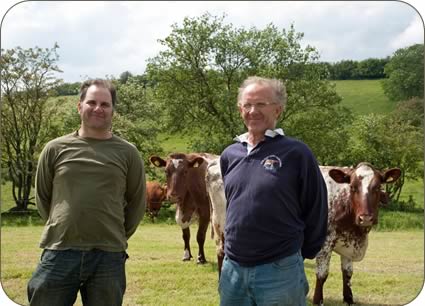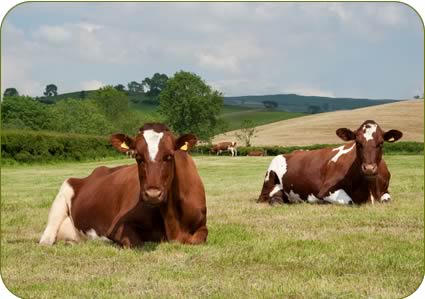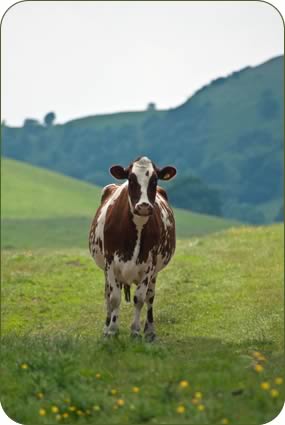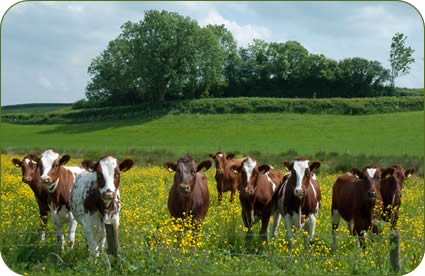Jennifer MacKenzie is an agricultural photo journalist with almost 30 year's experience. Operating from her base in Cumbria, Jennifer undertakes mainly industry-related freelance writing and photography.
Strickley Dairy Shorthorns
A pedigree Dairy Shorthorn herd which dates back 100 years is perfectly
suited to the management system on an organic farm on the edge of the Lake
District.
Farm inputs are low yet the 100 milkers which receive a premium for their organic milk earned the Strickley herd the highest place for the breed in National Milk Records’ revived Cumbria Herd Competition for the Robinson family.
James Robinson is the fifth generation of the family to farm Strickley, Old Hutton, Kendal since 1875 and he and his wife Michelle’s sons Chris, eight, and Robert, six, could well be the next.
 |
| James and his father Henry |
The family, including James’s parents Henry and Kathleen, are keen to promote farming to the general public and regularly host days for local school children which Michelle, a part time primary school teacher, generally runs, as well as visits from other organisations.
They are also keen to promote the merits of the Dairy Shorthorn and British genetics - the Strickley herd has been registered in the Coates herd book for 100 years.
While over the years the herd has been blended successfully with the Australian Illawarra, the Red and White Friesian and to a lesser extent, the MRI, the herd still averages 70% Shorthorn bloodlines.
“The Dairy Shorthorn is popular in countries such as North America and Australia, but I believe the best Shorthorns are still bred in this country,” said James, who is a member of the Shorthorn Society’s council.
“While our herd maintains a high proportion of Shorthorn blood, that is not the main breeding consideration. We’re breeding for type and performance,” he added.
“We’re looking to breed a robust animal but with plenty of dairy characteristics to produce milk but that is not too big and rangey as we are using the same buildings as 40 years ago. We want good udders and feet and legs and anything that we don’t want to breed from is put to the British Blue or Limousin.”
 |
| MIlking Cows |
The herd’s rolling 12 month average production is 7,289kg at 3.87% butterfat and 3.23% protein, and milk yields have increased by almost 1,000kg, however constituent values have dipped slightly since converting to organic seven years ago because of dietary changes. A number of cows have had 10,000kg lactations.
Herd fertility is very high with a calving index of 383 days and more than 70% holding to first service. Maintaining a tight calving pattern is a key part of herd profitability resulting in between 20 and 25 newly calved heifers at 26-28 months old sold annually to many repeat and new customers who include pedigree, commercial and organic producers. Many of the private sales are as a result of marketing via the Strickley website.
Cow longevity also allows more heifers to be sold. Cows are still milking in their ninth and tenth lactations and two cows have produced 80 tonnes of milk and are back in calf.
Milk is sold to OMSCo - the Organic Milk Suppliers Cooperative - which is supplying around a third of its milk into Europe for processing, and the rolling milk price currently is 34p a litre.
Since the move to organic farming the 250 lambing ewes made way for increased cow numbers from 80 to 110. The Robinsons farm 240 owner-occupied acres plus a further 45 acres of rented ground which they have also converted to organic status.
 |
| Cow |
While the Robinsons did not use a large amount of bought in fertiliser previously, with inputs reduced to nil they began a re-seeding programme with clover-rich swards.
With herbicides not allowed to be used under the organic system, weed control, and docks in particular, can be difficult, so the aim is to minimise weed growth in the re-seeding rotation.
During the last three years wholecrop has been grown on 15 to 20 acres, undersown with high sugar grass varieties mixed with clover. Tritcale was grown last year but while it produced a bulky crop, feed value was fairly low. This year wheat and peas have been grown.
Permanent pastures on ground too steep to plough have for the first time this year been slot seeded with thee improved varieties. Previously, attempts to harrow in new seed have not been very successful.
“We want to improve the grazing quality particularly in early to mid summer which is when we struggle with grass growth because we can’t fill the gap by using artificial fertiliser,” said James.
“We calve from mid July through August and September to get the late summer growth. Because of our clover mixtures we can probably graze later than conventional farms.
“Since going organic we have had to learn about soil management and fertiliser costs has been a big saving for us - up to 50 tonnes at say £15,000 a year.
“We have other costs with re-seeding but hopefully we’re getting the benefit back from the grass and silage quality which, in turn, will help our bought in feed bill,” he added.
 |
| Heifers in the buttercups |
The Robinsons are optimistic about this year’s first cut of silage taken on May 25. Two full cuts of silage are taken with a smaller third cut but with being organic the grass has to be rowed up and collected behind the mower to preserve quality.
All bought-in feed has to be fully organic. This includes straw which is fed as a buffer. An average 1.8 tonnes of concentrate is fed per cow which includes an 18% cake fed up to 8kg in the parlour and meal which is part of the main ration for M plus 22kg.
The winter ration generally comprises 3kg meal, 10kg of wholecrop and 30kg of grass silage, a mix of first and second cut and possibly the third cut big bales to increase protein content.
Because of restrictions on medicines, herd health and hygiene is paramount. Cell counts are running at 160 and across the herd there have only been 14 cases of clinical mastitis in 12 months.
Antibiotic use is kept to a minimum because withdrawal periods are three times longer than under conventional systems and veterinary treatments are limited to three times a year to maintain organic status.
Cows are treated with Orbeseal at drying off and last year only eight were given antibiotic dry cow therapy.
Bactoscan runs in the teens helped by the milking being shared by James and Henry and a strict milking routine, including pre teat dipping with Deosan Teat Foam and post dipping with Deosan Mastocide. Cows are kept out of the cubicles until milking is finished to allow the teat ends to close.
Herd numbers are at their optimum because of restrictions on organic nitrogen being spread on the land. The limit is 175kg/N per ha and current applications are at 150-160kg.
All the farm is in the LFA and several areas including a two acre pond, wetland and ancient oak woodland are in Organic Higher Level Stewardship, with the remainder of the farm in Organic Entry Level Stewardship.
As part of the OHLS, the Robinsons encourage educational visits to the farm which includes 25 local school visits a year. As a result, toilet and handwashing facilities have been created and a trailed personnel carrier is on order. A redundant farm building could also soon be converted into a classroom.
Other organisations which have regularly visited the farm include Cumbria Federation of WIs, the Soil Association and Natural England.

